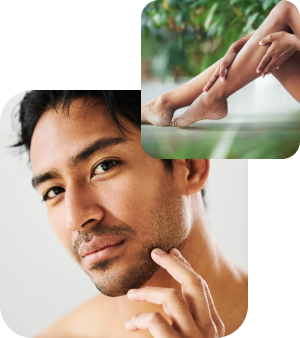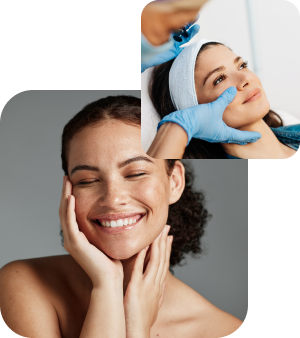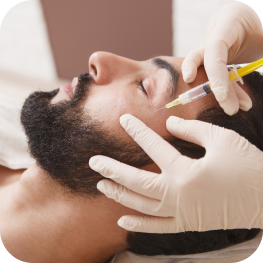Acne Scars

Acne is primarily a condition of young age, manifesting as unsightly pimples on the face, back, or chest. The risk involved is the development of scars, particularly on the face, and for this reason, treatment should be administered promptly. Acne treatment may include:
- Creams for topical application
- Antibiotic pills
- Isotretinoin, etc.
This is to prevent the progression of the condition and the further formation of scars.
Suitable for All Skin Types
Absolute Safety
No Side Effects
How are acne scars categorized?

- Atrophic scars: Due to chronic inflammation, there is a loss of skin tissue, resulting in two types of scars. Ice pick scars, which resemble punctures from a needle and can vary in depth, and boxcar scars, which are broader and less indented.
- Hypertrophic scars: These more often form on the back and are essentially raised scars caused by an abnormal deposition of collagen in the affected area of acne due to chronic inflammation.
Treatments for Acne Scars
Chemical Peeling
Chemical peeling is the application of a special liquid to the skin’s surface, stimulating the fibroblasts to produce collagen. This liquid is entirely safe for the body and causes exfoliation of the upper layers of the skin, improving the appearance of scars. The more concentrated and potent the solution, the more intense the exfoliation and the more effective the treatment.
Fractional Laser
Fractional laser has the ability to divide its beam into hundreds of fine beams to scan the skin without requiring significant recovery time after treatment.
It acts on fibroblasts, compelling them to produce collagen, giving our skin a brighter, younger, and firmer appearance. Fractional laser is the only laser that rejuvenates and refreshes the skin, eliminating the signs of aging and improving acne scars. The results are visible from the first session. Typically, 3-4 sessions are required, spaced approximately 20 days apart.
Hyaluronic Acid-Fillers.
The use of hyaluronic acid helps to “fill” atrophic scars, making them more superficial. The result is immediately visible. Treatment with hyaluronic acid can be easily combined with other treatments for scars, while similar effects can be achieved with autologous fat transfer.”
Expression of Interest Form
Error: Contact form not found.
Dermabrasion
For severe scars that do not respond to other treatments. Dermabrasion is performed under local anesthesia and is recommended in cases of extended scarring. Using a special machine, the upper layers of the skin are removed, resulting in the smoothing of the scars.
If the scars are very deep, some preparatory work might be needed before applying the above treatments. This process is known as punch elevation or punch excision. With our extensive experience, you can confidently trust the restoration of your scars to the Dermahair clinic.
FAQ
Dermabrasion is a type of minor surgical procedure applied in a dermatology clinic to treat scars, marks, tattoos, wrinkles, and generally to rejuvenate the facial skin.
Dermabrasion can be applied for:
- Skin restoration after scaring from acne, accidents, or past illnesses (such as chickenpox)
- Restoring skin with scars and marks from surgical incisions
- Για την αντιμετώπιση πανάδων και κηλίδων του δέρματος
- Treating dark spots and pigmentation of the skin
- Removing tattoos (where it can be more effective than laser, especially for removing bright colors like yellow and red)
- Treating wrinkles and generally rejuvenating the skin on the face.”
Dermabrasion is performed on clean skin using a specialized rotary tool that operates at high speeds, removing the outer layers of the epidermis to reveal the new skin beneath. Initially, local anesthesia is achieved in the application area, either with a cream or cryogenic spray, followed by the use of the rotary surgical tool to remove the upper layers of the skin. After the treatment, special creams are applied to the face, and bandages are placed to protect the area.”
The recovery time largely depends on the extent of the procedure—whether it’s mild or extensive—and the prior condition and quality of the skin. It’s important to follow the doctor’s instructions closely to minimize the risk of side effects or complications. For a few days after the procedure, the facial skin appears as if it has suffered from sunburn, with a noticeable red or pink hue. Regular washing and cleaning of the skin, applying special creams according to the doctor’s instructions, and taking medication to manage any pain or discomfort, as well as prevent any potential side effects, are all necessary. Within about 10 days, the skin returns to its natural state, while the pink color gradually fades. Within a few weeks, the skin regains its normal color.
The doctor’s instructions also include avoiding sun exposure for 3 months after the procedure, with the use of sunscreen being mandatory. For cases where the procedure is applied to localized areas, the area can simply be covered with a bandage until it fully heals.”
Dermabrasion achieves facial skin rejuvenation, revealing a brighter and more youthful appearance. It is considered 5 to 10 times more effective than chemical peeling and 2 to 3 times more effective than laser for facial rejuvenation and the treatment of deep wrinkles, while also offering a shorter recovery time. However, in cases of extensive or deep scars, surgical treatment may be required, usually performed about 2 months before dermabrasion.”
The dermatologist assesses the condition of the face, and depending on the severity of the case, suggests the appropriate treatment. They may also propose complementary treatments to maximize the positive outcome. However, there are cases where dermabrasion is contraindicated, and the dermatologist might recommend an alternative type of treatment.”
In some cases, it is recommended to apply collagen implants, hyaluronic acid, or autologous fat to address scars that have significant depth.”
Είπαν για εμάς
EXCELLENTTrustindex verifies that the original source of the review is Google. Τον εμπιστεύομαι χρόνια!! Είναι ένας εξαιρετικός επιστήμονας με πραγματικό ενδιαφέρον και γνώση για τον ασθενή!!Τον συνιστώ ανεπιφύλακτα τόσο για ιατρικά όσο και τις αισθητικές υπηρεσίες που προσφέρει ο χώρος.Trustindex verifies that the original source of the review is Google. Εξαιρετικός ιατρός, άριστα καταρτισμένος! Το ίδιο και όλο το προσωπικό! Πολλά μπράβο για όλη του την ομάδα!!Trustindex verifies that the original source of the review is Google. Εξαιρετικός γιατρός, τον συστήνω ανεπιφύλακτα!!Trustindex verifies that the original source of the review is Google. Excellent serviceTrustindex verifies that the original source of the review is Google. Έκανα αφαίρεση σπιλων με τον γιατρό και έμεινα απόλυτα ικανοποιημένη και από την διαδικασία αλλά και από την μετέπειτα παρακολούθηση μέχρι την αποθεραπεία !!!! Ευχαριστώ πολύ ❤️

HAIR TRANSPLANT;
Book a FREE 20 minute consultation for Hair Transplant!

Μήπως ενδιαφέρεστε για αυτές τις υπηρεσίες μας;



